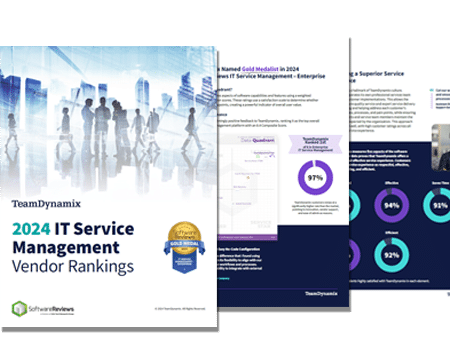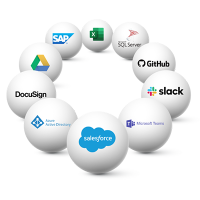
Understanding Change Management and Its Importance Within Your Organization
Did you know that a significant number of IT incidents occur when someone makes a change to one system that then affects other systems in

The Info-Tech ranking report offers a unique view of the market based entirely on in-depth customer interviews. Download the Info-Tech ITSM Quadrant and Customer Viewpoint report today.

We’ll show you some of our best situations and show you exactly how to execute them to get immediate results. The best part is, iPaaS tools often feature easy-to-use click and drag functionality, meaning you don’t need a dedicated employee building integrations and workflows.

System Integrators, Value Added Resellers, Technology Providers, and Buying Consortiums can benefit from a partnership with TeamDynamix.

The Info-Tech ranking report offers a unique view of the market based entirely on in-depth customer interviews. Download the Info-Tech ITSM Quadrant and Customer Viewpoint report to gain a better understanding of key vendor strengths and emerging market requirements.
For the last decade, there’s been a migration away from simple IT Service Management (ITSM) towards Enterprise Service Management (ESM). And more recently, this shift has evolved further into something we’re calling Smart Service.
What does Smart Service mean?
When you invest in Smart Service for your organization, you’re investing in service management that connects the entire enterprise and allows everyone to interact in real-time, supercharged by integration and workflow.
This evolution started with digital transformation initiatives and was spurred on by the need to modernize legacy systems while providing greater service delivery amidst the backdrop of a global pandemic.
Many organizations are quickly realizing the old standards of ITSM no longer apply to their rapidly changing IT and enterprise needs. Instead, they need an ITSM platform that goes beyond the ITIL framework and looks more broadly across the entire enterprise, not just as a glorified ITSM platform but as a true enterprise platform that facilitates service, collaboration and connectivity at a level never before achieved.
With the advent of iPaaS, organizations can now bring integration and workflow to the forefront – connecting ITSM platforms with the entire enterprise (which is often hundreds of point solutions from CRM and ERP to specific sales, marketing, recruiting and finance applications) for true enterprise service management.
To start, they use smart ITSM/ESM platforms that offer the traditional support for ITIL; end-user self-service; and both change and asset management – as it always has – as well as true enterprise service for groups like HR, Marketing and Facilities, all on a single codeless platform. However, to take this further, the ESM platform can connect across the full ecosystem of applications.
Integration and workflow are more easily achieved now using iPaaS – integration platform as a service. iPaaS provides an integration layer, or hub, that connects all enterprise systems with nodes for programs like Active Directory, ERP, CRM, Office365, Zoom, Workday, Salesforce, DocuSign, etc. Leveraging a library of pre-built connectors. Once connected, you can easily build out workflows and automation using a no-code visual flow builder – all connected to your ESM platform (or running independently as needed).
Today, most organizations are looking at ESM as the norm, however by adding an integration and workflow hub you can supercharge your efforts and bring far more benefits – creating a smart service platform. Curious how this works in practice? Here’s one example of how smart enterprise service management can enable a connected enterprise:
Imagine you work in HR at a large corporation and you’ve just had an offer letter returned with a signature – a new employee is about to start. There’s much to do!
In a connected enterprise, a service ticket could be generated to “Onboard Employee” and based on parameters gathered at that time, you can trigger workflows to automate this entire process including the provisioning of the user in the Active Directory, the user creation and permission settings for each of the required systems (all based on their people record in your HR system), no manual setup, no mistakes, no weeks-long ordeal. You can even set it up to initiate the sending of a welcome gift (using a third-party gift platform) and trigger a welcome email; it could also send a text to the hiring manager to let them know that the process has been completed—all hands-free.
A connected enterprise is agile and efficient and drives better outcomes.
By using an IT Service Management tool that includes integration and automation, you can free up your resources by automating the everyday, mundane tasks they normally have to complete before working on bigger projects – things like system name changes, resetting passwords, or granting certain permissions to software. All of these, and more, can be automated with workflows using iPaaS with your ITSM.
By combining iPaaS (integration platform as a service) with ITSM and Project Portfolio Management (PPM) on a single platform you can automate both complex and simple tasks, as well as connect disparate systems throughout your organization.
If you choose a codeless platform for this, you get the added benefit of anyone being able to use these tools – not just IT. By allowing lines of business to create their own workflows you can free up your IT resources to work on larger projects and eliminate the logjam when it comes to integrations within your organization.
Here are a few other ways iPaaS with ITSM/ESM can help reduce the IT drain on an organization:
Western University of Health Sciences (WesternU) has been using TeamDynamix iPaaS for more than a year now and had great results. “Things like onboarding and off-boarding users and updating permissions involved a lot of manual, tedious work before iPaaS,” Tech Support Manager Matthew Wright says. “These things happen on a regular basis, and they take away time that could be used more strategically to improve our customers’ IT experience.”
With the iPaaS in place, “we have been able to create internal automation that sets us up well for the future,” Nic Hayes, lead technical analyst, observes. Using the solution’s out-of-the-box connectors to common applications and systems, IT employees can easily automate IT processes without needing complex coding skills, creating true Integration Platform as a Service (iPaaS) functionality.
For instance, Enterprise Applications Administrator David Mitchell created an automated workflow to help with inventory control by connecting TDX iPaaS with their mobile device management (MDM) software. If an employee has a computer that hasn’t checked in within six months, Technical Support automatically receives a ticket that contains information about the device pulled from the MDM so they can follow up with the employee. WesternU has also automated processes for updating inventory records when a device is rebuilt or repaired.
At Pima County, they are using iPaaS for a variety of different use cases including onboarding and offboarding employees.
“You don’t need to waste so much time when it comes to onboarding,” Mark Hayes, information technology leader, said. “It really is such a sour experience for a new hire to come in, in this day and age, and sit around for three days waiting on their computer to show up. We need to get out of that mode and iPaaS is going to help us do that.”
In addition, using iPaaS to automate offboarding will save countless hours for a process that is normally very manual and heavily audited as Pima County is a government entity.
“As a government organization we get audited by the state every year and they want to know what these stale accounts are doing sitting here,” Hayes said. “Offboarding is currently a very manual process – having to review the list from HR of people who are no longer employed with us and manually revoking their privileges from all the different systems and software and disabling their accounts. There’s absolutely no reason for that to not be automated. iPaaS is going to help us a lot with this and save us time.”
Gainesville Regional Utilities has used TeamDynamix’s integration and automation capabilities to solve a key IT support challenge that affected thousands of retirees.
The software that handles payroll for GRU employees is Workday, which is supported by Gainesville’s IT department along with the other applications used by the city. Retired GRU employees receive their pensions through Workday as well.
However, prior to TeamDynamix, if retirees weren’t getting their pension checks or had trouble with their Workday account, they couldn’t submit a service request using GRU’s online service portal. Because retirees are no longer city employees, they don’t have an Active Directory account, and they need an Active Directory account to submit tickets to IT support staff online.
GRU Business Systems Analyst Tristina Grywalski worked with the TeamDynamix implementation and process consulting teams to develop a simple solution to this problem using the platform’s flexible configuration options.
As a result of their efforts, GRU retirees no longer have to call IT support staff during normal business hours, wasting valuable time for retirees and support staff alike. Instead, they can use the online service portal just like current employees with an Active Directory account can, resulting in faster and better service.
In just the first two months of this capability alone, more than 150 retired GRU employees from all across the country had submitted service requests online. “The service team is very grateful for this solution,” Grywalski said.
This article was originally posted in March 2021 and has been updated with new information.






Recently a group of technology leaders from the retail, healthcare, and higher education sectors got together to talk about how they’re approaching digital transformation and building connected enterprises that blend people, processes, and technology.

Did you know that a significant number of IT incidents occur when someone makes a change to one system that then affects other systems in

The construction industry can be very volatile, with a high employee turnover rate due to seasonal fluctuations in the workforce. A key challenge for the

A study from Information Week and TeamDynamix shows companies are looking to invest in IT Service Management (ITSM) software that is simple to administer and
TeamDynamix’s award-winning SaaS cloud solution offers IT Service and Project Management together on one platform with enterprise integration and automation.
[email protected]
(877) 752-6196
Contact Us
